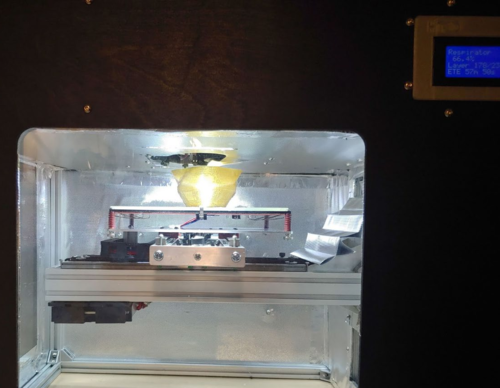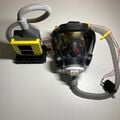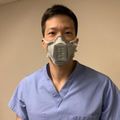Template:Statusboxtop Template:Status-design Template:Status-model Template:Status-prototype Template:Status-verified You can help Appropedia by contributing to the next step in this OSAT's status. Template:Boxbottom
Source
- Noah G.Skrzypczak, Nagendra G.Tanikella, Joshua M.Pearce. Open source high-temperature RepRap for 3-D printing heat-sterilizable PPE and other applications. HardwareX 8,(2020), e00130 https://doi.org/10.1016/j.ohx.2020.e00130 open access preprint
- Source code: https://osf.io/gbjvf/
Abstract

Thermal sterilization is generally avoided for 3-D printed components because of the relatively low deformation temperatures for common thermoplastics used for material extrusion-based additive manufacturing. 3-D printing materials required for high-temperature heat sterilizable components for COVID-19 and other applications demands 3-D printers with heated beds, hot ends that can reach higher temperatures than polytetrafluoroethylene (PTFE) hot ends and heated chambers to avoid part warping and delamination. There are several high temperature printers on the market, but their high costs make them inaccessible for full home-based distributed manufacturing required during pandemic lockdowns. To allow for all these requirements to be met for under $1,000, the Cerberus – an open source three-headed self-replicating rapid prototyper (RepRap) was designed and tested with the following capabilities: i) 200°C-capable heated bed, ii) 500°C-capable hot end, iii) isolated heated chamber with 1kW space heater core and iv) mains voltage chamber and bed heating for rapid start. The Cereberus successfully prints polyetherketoneketone (PEKK) and polyetherimide (PEI, ULTEM) with tensile strengths of 77.5 and 80.5 MPa, respectively. As a case study, open source face masks were 3-D printed in PEKK and shown not to warp upon widely home-accessible oven-based sterilization.
Keywords
open hardware, COVID-19, RepRap, 3-D printing, additive manufacturing, personal protective equipment, safety equipment, medical hardware, open source medical hardware, high temperature 3-D printing, ULTEM, polycarbonate
See also
- A review of open source ventilators for COVID-19 and future pandemics
- Open-Source Medical Hardware for Pandemics
- Parametric Nasopharyngeal Swab for Sampling COVID-19 and Other Respiratory Viruses: Open Source Design, SLA 3-D Printing and UV Curing System
- Maximizing Returns for Public Funding of Medical Research with Open-source Hardware
- Economic Potential for Distributed Manufacturing of Adaptive Aids for Arthritis Patients in the U.S.
- 3-D printing open-source click-MUAC bands for identification of malnutrition
- Emergence of Home Manufacturing in the Developed World: Return on Investment for Open-Source 3-D Printers
- Life-cycle economic analysis of distributed manufacturing with open-source 3-D printers
- Distributed Manufacturing of Flexible Products- Technical Feasibility and Economic Viability
- Quantifying the Value of Open Source Hardware Development
- Low-cost open source ultrasound-sensing based navigational support for visually impaired
- Open-Source Three-Dimensional Printable Infant Clubfoot Brace
- Conversion of Self-Contained Breathing Apparatus Mask to Open Source Powered Air-Purifying Particulate Respirator for Fire Fighter COVID-19 Response
See also COVID-19 resources from MOST
- 2020 Michigan Tech Open Sustainability Technology Group COVID19 Projects & Publications


















